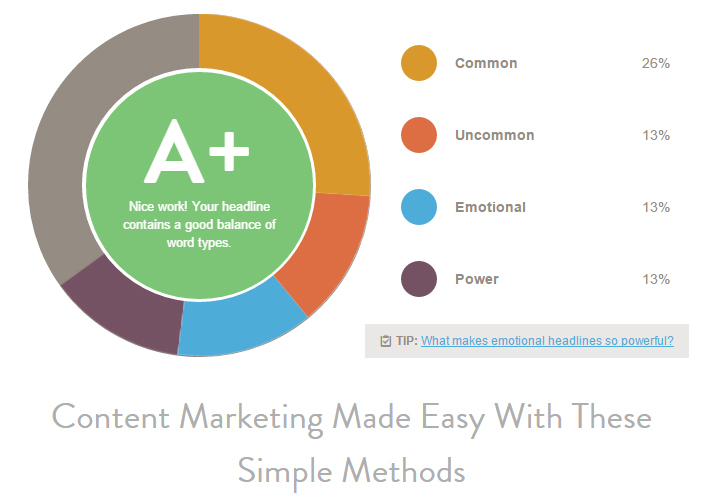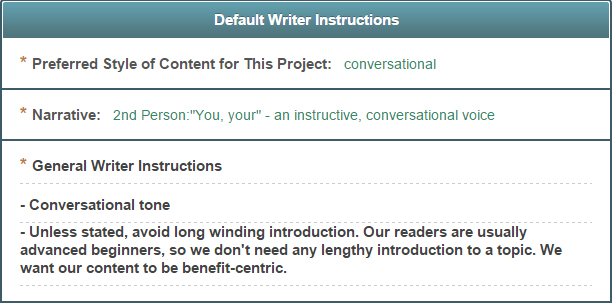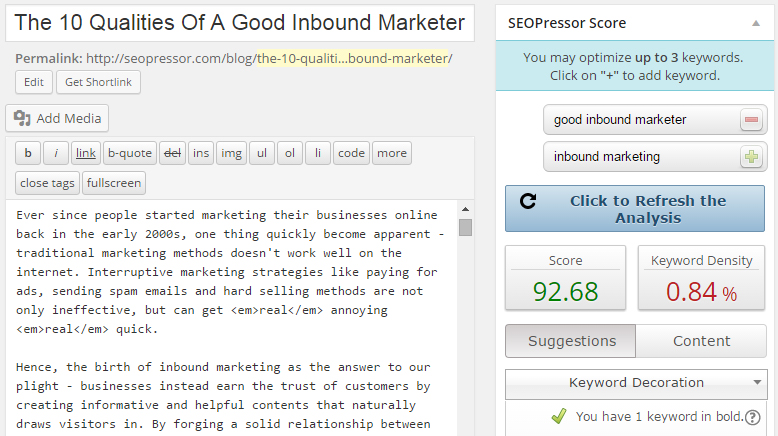Steph W. from SEOPressor


...help you check your website and tell you exactly how to rank higher?


70
score %
SEO Score

Found us from search engine?
We rank high, you can too.
SEOPressor helps you to optimize your on-page SEO for higher & improved search ranking.
By winniewong on October 7, 2015

Content marketing doesn’t really sound that difficult, right? You’ve done a little bit of reading on the subject matter – and it’s obvious that all you really have to do is set up a blog and then write a couple of posts every week, making sure to throw in some keywords and links. Unfortunately, it’s nowhere near as simple as this.
Content marketing is a much more involved process, from the generation of content ideas to the promotion of published content, and it takes up a lot of time and resources in order to do properly and successfully. Fortunately, for all of you bloggers and marketers out there, there are plenty of proven methods as well as tools available – many of them free – that can help make this process go a little smoother.
The following is a basic breakdown of the entire content marketing process along with a number of methods and tools to help you succeed:
[bof_display_offer id=9679]

Coming up with things to write sounds easy until you are required to churn out tens of topics each week.
You may have in-depth knowledge on the process of content marketing to the point where you’re convinced your strategy will help you to accomplish all of your online marketing goals. However, if you can’t come up with ideas for your blog posts on a regular basis, then you’re basically stumbling out of the starting gate.
Having to keep on finding new ideas to write can be very hard, even if you’re knowledgeable about your respective industry. The following are a few ways that you can begin generating more ideas so that you’ll always have something to write about:


Co-Schedule’s Headline Analyzer grades your title and give suggestions on further improving them.

Take a peek into SEOPressor’s top secret Content Marketing plan!
Once you’ve got ideas for your content, you’re going to have to actually write it. This is actually a lot tougher than you might think. Just because you are an authority on the subject matter does not make you a good writer. Besides having to worry about spelling and grammar, you’ll also have to create a personable voice behind your blog that readers can relate too. You don’t want your blog posts to sound like generic Wikipedia entries, after all. Use the following two resources that can help you with content writing:

Zerys’ system and UI is among the best when it comes to finding freelance writers.

Using Grammarly can dramatically reduce the likelihood of being ambushed by Grammar Nazis.
All of your blog posts should be accompanied by a relevant image. Images are vital to a successful content platform because we are just generally more attracted to visual content than text. Images, such as photos, give readers a chance to glance over your blog post and to get an idea of what it’s about without having to read much. They also help break up the text to make the format of your blog more appealing. Charts and infographics are also a great way to use images to help convey data in a more visual way.The following are a few tools that can help you find and use images for your blog:

Online design tools such as Canva allows you to effortlessly create stylish artworks to be used in your content.
Once you’ve written a blog post, you’re going to need to optimize it for SEO (search engine optimization). This can require a bit of effort as well since you’re going to need to use high quality keywords in addition to LSI keywords to make it easier for Google to identify what your content is about and how to rank it. Keep your keywords relevant and make sure you don’t overuse them to avoid penalties from Google.

On-page SEO can be quite a hassle, that’s why we come up with SEOPressor to simplify the process.
Keywords should be used in your blog titles, meta descriptions, H1 and H2 tags, anchor text, image ALT text and the actual body of your content. Be sure to use our SEOPressor tool to analyze your on-page SEO. The tool will scan your use of keywords and provide you with an overall SEO score, a keyword density number and suggestions for how to improve your optimization.
No matter how awesome your contents are, it won’t attract readers just by existing. You need to promote your blog content in order to kickstart the first batch of traffic to your content. Only after your content gets a certain amount of traffic and backlinks are Google going to notice that it is actually good and rank it. The following are effective content promotion methods that you should implement into your content marketing strategy:

A “weekly digest” type of e-newsletter is a great way to promote contents to your own subscribers.

Sharing on your social media pages as well as online communities will send tons of traffic to your contents.
The content marketing process doesn’t just end with promotion. You need to see how your content is performing so that you can adjust your strategy where needed. There are a number of analytics tools available that will help provide you with valuable data concerning how your content is performing.

Tracking the amount of traffic your contents are earning lets you know whether they are working or not.
Tools such as Google Analytics and Kissmetrics can provide you with all kinds of data, including page visits, bounce rates, dwell times, conversion rates, click-through rates and more. You should also use the RankReveal tool, which will provide you with a list of all the keywords you are ranking as well as if those keywords have risen or dropped in ranking.
As you can see, great content marketing can involve a lot of tedious processes. But with the right tools and techniques, you can blaze through to both make them more efficient as well as produce better results. All the tips listed in this post is something we gathered through our own experience. I’d love to hear yours as well so do share your own tips on how you zip your way through content marketing!
Updated: 29 December 2025


Save thousands of dollars (it’s 100x cheaper)

Zero risk of Google penalty (it’s Google-approved)

Boost your rankings (proven by case studies)
Rank High With This Link Strategy
Precise, Simplified, Fast Internal Linking.
